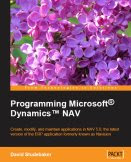
Author: David Studebaker
Publisher: Packt Publishing
ISBN: 1904811744
Published: October 2007
This is currently the only book that covers programming Microsoft Dynamics NAV and that for most people will be a good-enough reason to buy it.
The book is intended to help reduce the time needed for non-NAV programmers to become productive with NAV’s unique programming language and development tools. From its coverage of terminology and basic concepts to advanced topics and techniques, this book is not just for the NAV-newbie; there is enough advanced content and good advice to prove useful for the seasoned NAV developer too. According to the preface, the book is also intended to help managers and those considering purchasing or enhancing the product to become familiar with the level of customisation the product can provide.
David Studebaker has been programming NAV since 1996 and, with over 40 years IT experience, he is well-qualified to write this book. He is currently a principal of a company that provides development, consulting, training and upgrade services for NAV resellers and firms using NAV. It is rare to get the opportunity to work with someone with such experience and this book may be the closest you’ll ever get to having a true veteran provide mentoring and advice.
Overall this is a good book, but it could have been a lot better. The publisher claims this is a “Fast-paced and to-the-point... [book with] …clear explanations and practical example code.” However, I found some of the early chapters rambling, slow and tedious with more than a handful of mistakes. The chapter on fields in particular contained a number of basic errors that should have been picked up by the proof reader or reviewers. At times I felt as though I was the first person to actually read this book.
Whilst David is clearly a very experienced NAV developer, he is not a great writer, so do not expect an easy read. Some explanations are long-winded and prone to tangential wanderings. It seems that, subconsciously at least, David is aware of his propensity to ramble when, after a 5-page-explanation of the “Date Formula” data type including a programming example, he writes: “It may seem that we overemphasized this experiment. But you got to see a lot more here than just date calculations.” A good editor could have helped us all at this point.
I really wanted to like this book and essentially I do. The content is undoubtedly good, so do not be put off by my criticisms. In value-for-money terms this book is exceptional: try to see how much consultancy or training time 60 US Dollars will buy you!
David has done a great job in completing this book and has obviously invested a lot of time for what must be a tiny market. If you work with NAV you should buy this book.
The book is intended to help reduce the time needed for non-NAV programmers to become productive with NAV’s unique programming language and development tools. From its coverage of terminology and basic concepts to advanced topics and techniques, this book is not just for the NAV-newbie; there is enough advanced content and good advice to prove useful for the seasoned NAV developer too. According to the preface, the book is also intended to help managers and those considering purchasing or enhancing the product to become familiar with the level of customisation the product can provide.
David Studebaker has been programming NAV since 1996 and, with over 40 years IT experience, he is well-qualified to write this book. He is currently a principal of a company that provides development, consulting, training and upgrade services for NAV resellers and firms using NAV. It is rare to get the opportunity to work with someone with such experience and this book may be the closest you’ll ever get to having a true veteran provide mentoring and advice.
Overall this is a good book, but it could have been a lot better. The publisher claims this is a “Fast-paced and to-the-point... [book with] …clear explanations and practical example code.” However, I found some of the early chapters rambling, slow and tedious with more than a handful of mistakes. The chapter on fields in particular contained a number of basic errors that should have been picked up by the proof reader or reviewers. At times I felt as though I was the first person to actually read this book.
Whilst David is clearly a very experienced NAV developer, he is not a great writer, so do not expect an easy read. Some explanations are long-winded and prone to tangential wanderings. It seems that, subconsciously at least, David is aware of his propensity to ramble when, after a 5-page-explanation of the “Date Formula” data type including a programming example, he writes: “It may seem that we overemphasized this experiment. But you got to see a lot more here than just date calculations.” A good editor could have helped us all at this point.
I really wanted to like this book and essentially I do. The content is undoubtedly good, so do not be put off by my criticisms. In value-for-money terms this book is exceptional: try to see how much consultancy or training time 60 US Dollars will buy you!
David has done a great job in completing this book and has obviously invested a lot of time for what must be a tiny market. If you work with NAV you should buy this book.


No comments:
Post a Comment